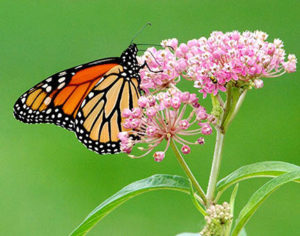I’m often asked what is the best species of milkweed to grow for monarchs. In many ways, the answer is whatever species is native to your area and has the tastiest leaves for the monarch caterpillars to eat at that particular instant in time. Let’s talk about that statement for a minute, why it’s true and how we can use that knowledge to our advantage.
Milkweed Diversity
Common milkweed (Asclepias syriaca), swamp or rose milkweed (A. incarnata), and butterfly milkweed (A. tuberosa) are the most commonly planted milkweeds for monarchs east of the Mississippi River. However, those are definitely not the only species of milkweed native to this area. There are approximately 100 species of milkweed native to North America, and roughly a quarter of those are native to at least some part of the country east of the Mississippi River.
Each of these different species of milkweed grows in different habitats, grows to different heights, has different sized leaves, blooms at different times, dies back at different times, etc. And all of these factors can make the vegetation more or less attractive as place for mama monarchs to lay their eggs. No single species is going to be “the best choice” for monarch caterpillars all season long or in all locations.
Monarch Egg Laying Behavior
The saying “mother knows best” is true for the babies of so many different species, including monarchs. Mother monarchs will preferentially lay their eggs on milkweeds that they detect will provide the best food for the monarch caterpillars that hatch. For example, early in the season, they often prefer to lay their eggs on taller species with wider leaves. Later in the season, those originally preferred species tend to get tougher vegetation or die back. At that point, the mother monarchs will often switch to laying more eggs on shorter milkweed species or species with thinner leaves that stay relatively tender.

How We Can Use This Knowledge
Planting multiple species of milkweeds that are native to your location can encourage egg laying monarchs to visit your property. Having access to several different species of milkweed provides the mothers with the opportunity to choose the species that will be best for their caterpillars at that particular point in the season.
True, it might take a little extra effort to find some of the milkweed species that are native to your area, but you don’t need to have all of them. Even just growing butterfly milkweed and either common milkweed or swamp / rose milkweed will provide valuable milkweed diversity in your garden or on your property.
The good news is that butterfly milkweed, common milkweed, and rose milkweed or swamp milkweed are all relatively easy to find in native plant nurseries. (If you are buying your milkweed at a nursery that doesn’t specialize in native plants, then pay close attention to the scientific names. There is a non-native species that sometimes goes by some variation of the common name butterfly milkweed. However, some research shows it isn’t as good for monarchs in this region as our native species.)
If you want to add other species of milkweed to your property and can find them, then even better. But, just having two or three different species will do just fine. Both the monarch caterpillars and their mamas will thank you for the diversity.

Backyard Ecology: Exploring Nature in Your Backyard
Nature isn’t just “out there.” It’s all around us, including right outside our doors. Hi, my name is Shannon Trimboli, and I am the host of Backyard Ecology. I live in southcentral Kentucky and am a wildlife biologist, educator, author, beekeeper, and owner of a nursery specializing in plants for pollinators and wildlife conservation. I invite you to join me as we ignite our curiosity and natural wonder, explore our yards and communities, and improve our local pollinator and wildlife habitat. Learn more or subscribe to my email list at www.backyardecology.net.

Leave a Reply